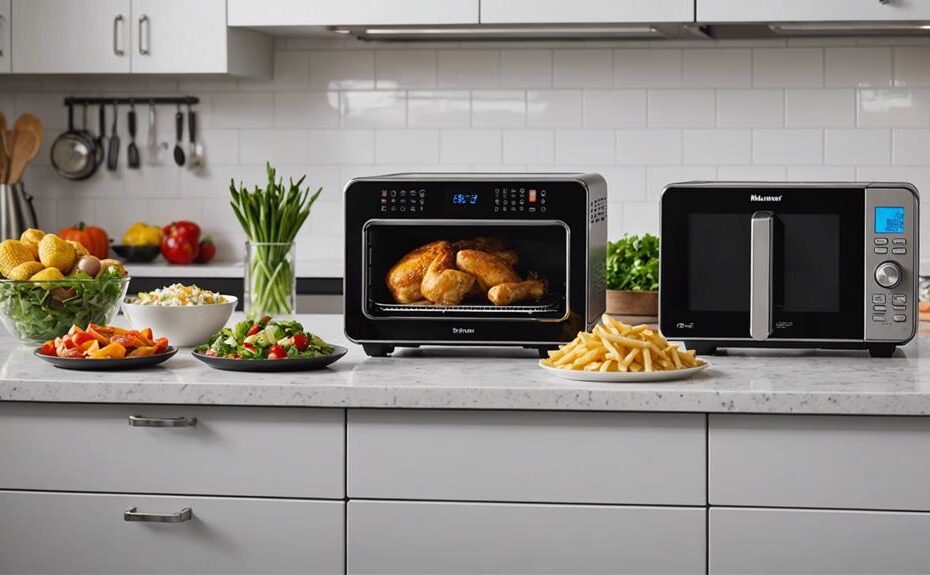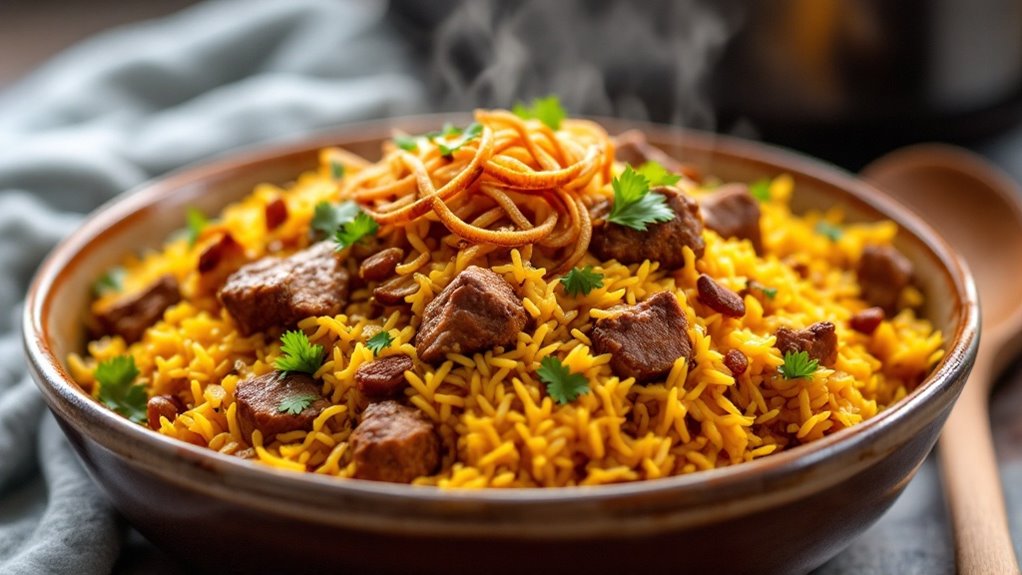Air fryers offer diverse cooking methods such as frying, baking, roasting, and grilling. They use hot air circulation to achieve crispy textures with less oil, making them efficient and convenient. However, air fryers can't fully replace microwaves, which excel in quick heating, defrosting, and nutrient preservation due to microwave radiation. Air fryers consume less energy and promote healthier eating by reducing fat intake, while microwaves are more budget-friendly and intuitive for everyday tasks. Each appliance has its strengths and limitations, influencing your cooking experience differently. For more insights into choosing between these appliances, keep exploring.
Key Takeaways
- Air fryers provide versatile cooking methods but lack the rapid reheating and defrosting capabilities of microwaves.
- Air fryers offer healthier cooking with less oil, while microwaves excel at nutrient retention.
- Air fryers are more energy-efficient, potentially reducing long-term energy costs compared to microwaves.
- Microwaves are more budget-friendly initially and simpler to maintain due to fewer moving parts.
- Air fryers are compact and space-efficient, ideal for kitchens with limited space, unlike microwaves which require more countertop area.
Air Fryer Functions
Leveraging hot air circulation, air fryers cook a variety of foods like fries, chicken wings, and vegetables with a crispy texture, offering a healthier alternative to deep frying with minimal to no oil. You might find that an air fryer can replace your traditional oven for many daily cooking tasks due to its efficiency and convenience. Unlike conventional ovens, air fryers use rapid air technology to cook food quickly and evenly, ensuring uniform results without the need for preheating.
Air frying allows for a versatile range of cooking methods, including baking, roasting, grilling, and frying. For instance, you can bake a small batch of cookies, roast vegetables, or grill a piece of fish all in one compact appliance. This versatility makes air fryers a valuable addition to your kitchen.
Additionally, air fryers excel at reheating food. Unlike microwaves, which can make leftovers soggy, air fryers reheat food while maintaining its original texture and flavor. This capability is particularly useful for foods that lose their crispiness in a microwave. By considering these functionalities, you can see how an air fryer might replace multiple kitchen appliances, streamlining your cooking process and enhancing your meal quality.
Microwave Capabilities
Microwaves are indispensable for their ability to quickly heat, defrost, and reheat food using microwave radiation, making them a staple in many kitchens. These versatile appliances excel at rapid and uniform heating, which is crucial for defrosting frozen items, reheating leftovers, and cooking certain foods like vegetables and softening butter. The speed and convenience microwaves offer are unmatched in small kitchens where space is limited.
One key advantage of microwaves is their efficiency in performing quick heating tasks. You can defrost a frozen meal within minutes or warm up last night's dinner without guaranteeing taste or texture. While microwaves don't provide the crispy texture that air fryers can achieve, their ability to uniformly heat food ensures that dishes are evenly warmed throughout.
Moreover, microwaves can handle a variety of cooking tasks beyond just heating and defrosting. From baking cakes to steaming vegetables, their functionality extends to numerous culinary applications. This versatility makes them a valuable asset in any kitchen, especially when quick preparation is needed. Ultimately, while they might lack the crisping function of an air fryer, microwaves remain an essential tool for efficient and rapid food preparation.
Cooking Speed Comparison
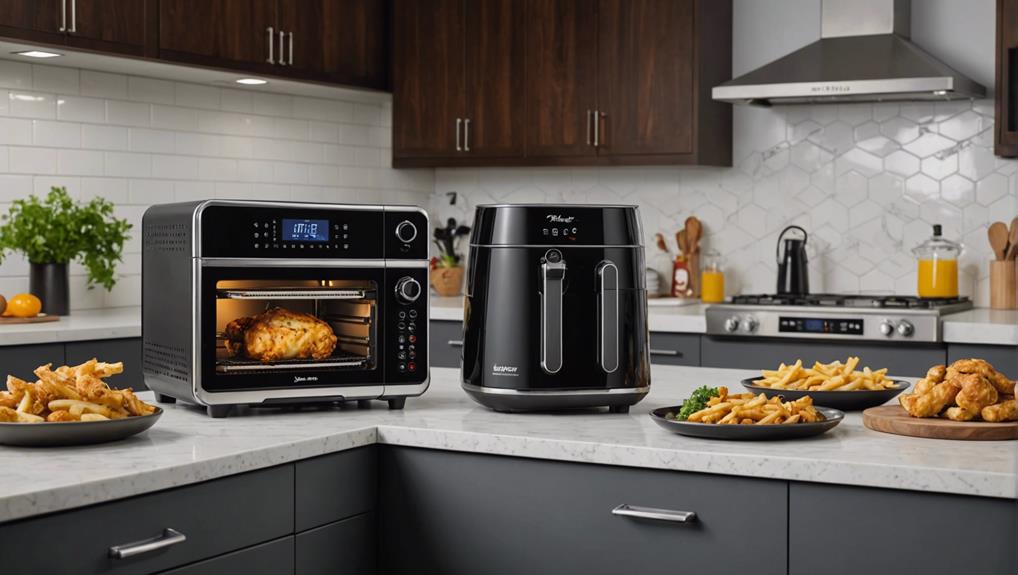
While microwaves excel in rapid and uniform heating, air fryers often outpace them in cooking speed due to their hot air circulation and convection methods. When you need to prepare food quickly, an air fryer can be a more efficient choice for certain types of dishes. The hot air circulation within an air fryer allows for faster cooking times, especially for foods that require a crispy exterior, like chicken wings or fries. This cooking method guarantees that the food not only cooks quickly but also achieves a desirable texture that microwaves can't replicate.
Microwaves, on the other hand, are unparalleled when it comes to reheating small portions of food. They use electromagnetic waves to heat the food uniformly and rapidly, making them ideal for tasks such as warming leftovers or defrosting frozen items. However, they fall short in producing a crispy skin or crust, which is a forte of air fryers.
In essence, if you're looking for speed combined with texture, air fryers have a distinct advantage. They can cook food quickly while ensuring a crispy finish. Microwaves, though quicker for reheating, can't match the crispy textures that air fryers deliver efficiently.
Energy Efficiency
When evaluating energy efficiency, air fryers typically outperform microwaves due to their use of hot air circulation for cooking. Air fryers are designed to be more energy-efficient since they don't rely on electromagnetic waves but rather circulate hot air to cook food evenly. This method requires less energy to reach and maintain cooking temperatures, thus reducing overall power consumption.
Microwaves, on the other hand, can consume more energy, especially during extended use. When heating liquids or foods with high water content, microwaves tend to use more power, leading to higher energy consumption. In contrast, air fryers maintain efficient energy use regardless of the food type, thanks to their consistent hot air circulation.
Moreover, air fryers often contribute to lower energy bills. They generally cook food faster and more efficiently, reducing the appliance's operational time. This efficiency means less energy is consumed per cooking session. By choosing an air fryer over a microwave, you can benefit from reduced energy consumption in your kitchen.
Versatility in Cooking
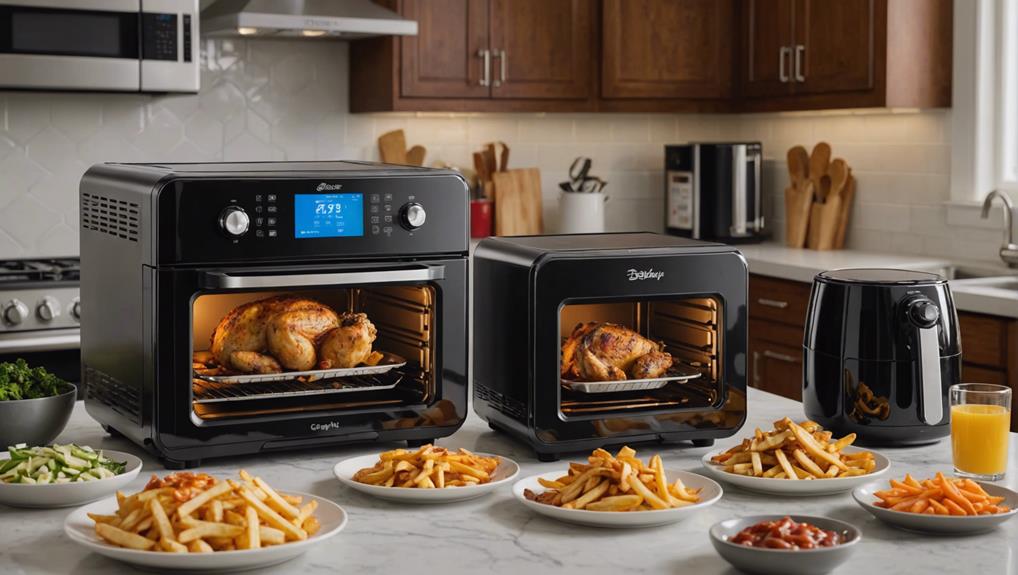
Air fryers offer a multitude of cooking options, such as frying, baking, roasting, and grilling, making them highly versatile in the kitchen. When you compare this to microwaves, the difference in versatility in cooking becomes clear. Microwaves are generally restricted to heating, defrosting, and performing basic cooking tasks. While convenient, they lack the breadth of cooking methods that air fryers provide.
When you use an air fryer, you can achieve crispy textures similar to deep-frying but with much less oil, making your meals healthier. This versatility means you can prepare a wider range of dishes, from crispy French fries to baked goods and roasted vegetables, all with one device. Microwaves can't replicate this variety; they excel in quick reheating but fall short in delivering the same culinary diversity as an air fryer.
If you want a more diverse culinary experience, an air fryer is the way to go. It not only replaces some of the microwave's functions but also adds new dimensions to your cooking repertoire, making it a valuable addition to your kitchen. Combining both appliances can balance quick heating with versatile cooking options, optimizing your meal preparation process.
Reheating Food
Reheating food in an air fryer maintains the original texture and crispiness, making it a superior option compared to the often soggy results from microwaves. When you reheat leftovers in an air fryer, the hot air circulation guarantees that your food remains crispy on the outside and preserves its original texture. This is particularly beneficial for items like pizza, fries, and fried chicken, where texture is key to an enjoyable eating experience.
In contrast, microwaves are quicker for reheating tasks, especially for liquids and softer foods. However, this speed comes at the cost of food quality. Microwaves often result in uneven heating and can leave you with a soggy, less appetizing meal. This difference in quality can be attributed to how microwaves heat food from the inside out, while air fryers use convection to evenly surround the food with hot air.
The choice between an air fryer vs microwave for reheating food ultimately depends on your priorities. If you're looking for speed and convenience, a microwave might be your go-to. However, if you value the texture and overall taste of your reheated food, an air fryer offers a more satisfying result.
Health Considerations
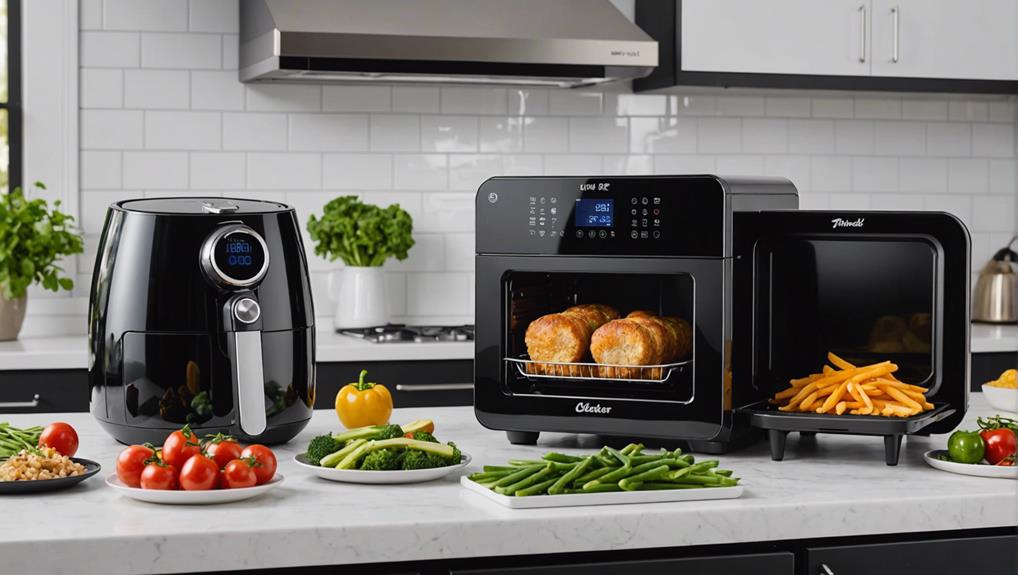
Choosing between an air fryer and a microwave involves weighing the health benefits each appliance offers, such as reduced oil consumption with air fryers and nutrient retention with microwaves. When you use an air fryer, you notably reduce the amount of oil needed to cook food, which can help decrease your overall calorie intake. This makes air fryers an excellent choice for those aiming to lower their fat consumption while still enjoying crispy textures.
On the other hand, microwaves excel at nutrient retention. When you cook or reheat food in a microwave, the short cooking times and minimal use of water help preserve essential vitamins and minerals. This is particularly beneficial for vegetables and other nutrient-dense foods.
Air fryers and microwaves both promote healthier eating habits, but they do so in different ways. If you're focused on reducing oil and calories, using an air fryer might be the better option. Conversely, if nutrient preservation is your priority, microwaves offer a clear advantage. Ultimately, the choice between these appliances can influence your diet based on your specific health goals and cooking preferences.
Ease of Use
Both air fryers and microwaves offer user-friendly interfaces, but the simplicity of their controls and preset functions can make a significant difference in your cooking experience. Air fryers typically come with straightforward controls, often featuring digital displays and preset cooking functions for a variety of foods. This makes them incredibly easy to use, especially if you're preparing common items like fries or chicken wings. Their minimal preheating time adds to their convenience, allowing you to start cooking almost immediately.
Microwaves, on the other hand, are renowned for their ease of use when it comes to quick heating, reheating, and defrosting. Most come with simple, intuitive interfaces and preset options for tasks like popcorn, beverages, and defrosting meat. These settings make microwaves highly convenient for everyday use. However, they don't offer the same versatility in cooking methods as air fryers.
When comparing the two, the ease of use in air fryers is more about setting cooking parameters for specific dishes, whereas microwaves simplify quick, everyday tasks. Both appliances excel in different aspects of ease of use, making them complementary rather than interchangeable in your kitchen.
Cost Analysis
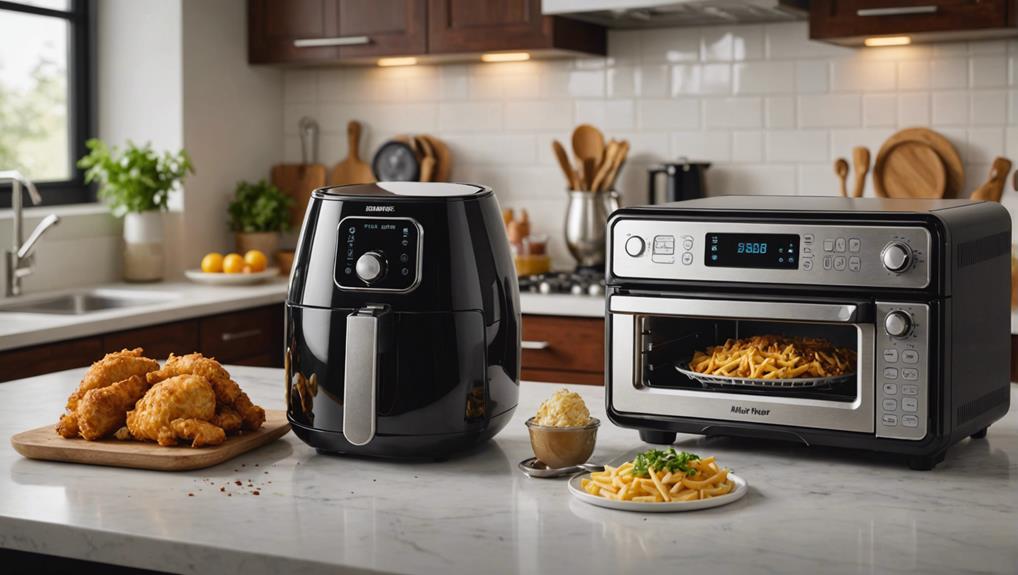
While air fryers often come with a higher initial price tag, microwaves are generally the more budget-friendly option for most households. When conducting a cost analysis, you'll find that microwaves typically range from $50 to $150, making them accessible for a wide range of budgets. On the other hand, air fryers can cost anywhere from $70 to $300, depending on the brand and features.
However, it's important to take into account long-term savings. Air fryers are generally more energy-efficient, potentially reducing your electricity bill over time. They use less power by cooking food faster and more evenly than a microwave. Despite this, the savings might be marginal and could take years to offset the higher initial cost.
Maintenance is another factor to think about. Air fryers often have components like filters that need regular cleaning or replacement, adding to the long-term costs. Microwaves, with fewer moving parts, usually have lower maintenance expenses and a longer lifespan, making them a cost-effective choice for many consumers.
Space and Size
Considering space and size, air fryers offer a more compact solution, making them ideal for kitchens with limited countertop space. Unlike microwaves, which typically have a larger footprint and can dominate your kitchen area, air fryers are designed to be both space-efficient and versatile. Their smaller size allows them to fit comfortably on countertops or be stored away when not in use, thereby optimizing your kitchen's layout.
Microwaves, on the other hand, require more space due to their bulkier design. This larger footprint can be a significant drawback if you have a smaller kitchen or limited countertop space. Additionally, microwaves are generally less versatile in terms of placement and storage options, often necessitating a dedicated spot in your kitchen.
In contrast, air fryers excel at maximizing kitchen space efficiency. Their compact nature makes them a practical choice for individuals looking to save space while still enjoying convenient cooking options. You can easily move an air fryer around, whether you're preparing a quick meal or storing it away after use. If space and size are key considerations for you, an air fryer stands out as the more adaptable and space-efficient option.
Frequently Asked Questions
Can Air Fryers Replace the Microwave?
You'll find air fryers enhance cooking efficiency and offer better texture for crispy foods. They save space and provide healthier options. However, microwaves excel in reheating quality and speed, making them indispensable for quick heating tasks.
Which Is Better, a Microwave or an Air Fryer?
"Different strokes for different folks." If you value energy efficiency and crispy food texture, choose an air fryer. For quicker cooking times and versatility, a microwave's better. Assess your priorities to make the best decision.
Can an Air Fryer Warm up Food Like a Microwave?
You can warm up food with an air fryer, but it's not as efficient for reheating as a microwave. However, it offers better texture differences and guarantees food safety by evenly warming, enhancing crispiness and flavor.
What Appliance Does an Air Fryer Replace?
Believe it or not, an air fryer can step in for a convection oven, toaster oven, and deep fryer. With its rapid hot air circulation, you'll enjoy crispy, healthier meals without the extra oil or hassle.
Conclusion
So, can air fryers replace microwaves? Well, if you love waiting longer for your food, enjoy consuming more electricity, and relish the idea of owning a bulkier kitchen gadget, then absolutely! Sure, air fryers offer healthier cooking options and versatility, but microwaves are the undefeated champions of speed and simplicity. Ultimately, you'll just need to decide if you're more of a health-conscious chef or a convenience-loving eater. Don't worry, your kitchen counters will forgive you either way.
Disclosure: As an Amazon Associate, I earn from qualifying purchases.
